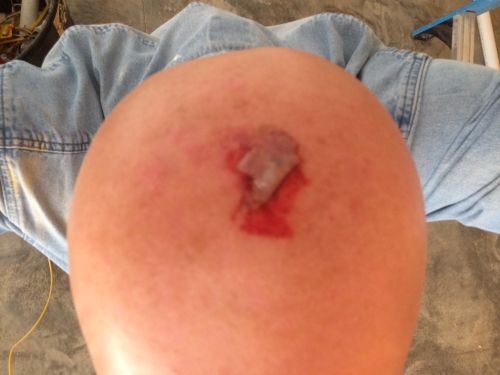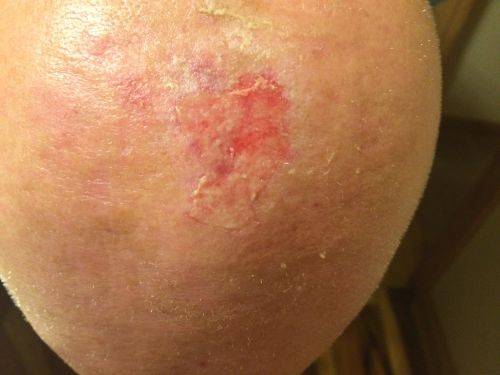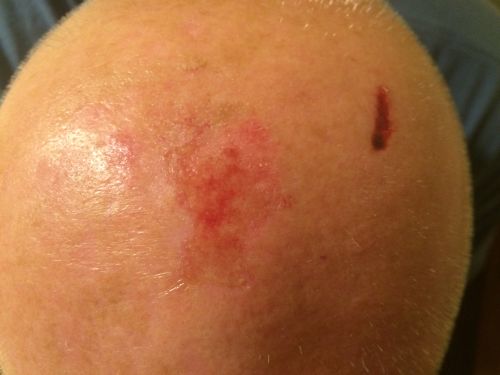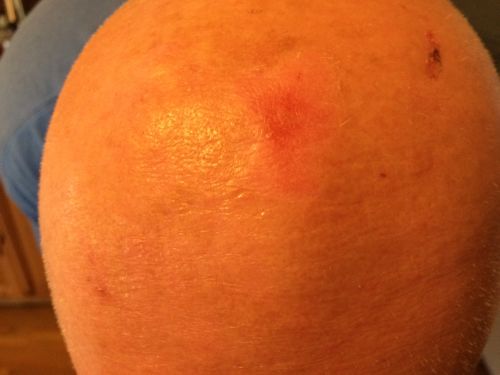| 5 star (1) | 100% |
Mama To Many (Tn) on 11/20/2017: 
 My husband cut his scalp a couple of weeks ago. I used the principles of moist wound healing to treat it. We took pictures to monitor the progress. I have posted at the bottom; sorry the first one is pretty icky! He took the picture with his phone and texted it to me to ask what he should do for it. We didn't begin treating it until he got home from work and showered. In the shower, he removed the piece of skin that was still sticking to the wound. (He scraped off a layer of skin climbing into a work trailer.)
My husband cut his scalp a couple of weeks ago. I used the principles of moist wound healing to treat it. We took pictures to monitor the progress. I have posted at the bottom; sorry the first one is pretty icky! He took the picture with his phone and texted it to me to ask what he should do for it. We didn't begin treating it until he got home from work and showered. In the shower, he removed the piece of skin that was still sticking to the wound. (He scraped off a layer of skin climbing into a work trailer.)
After the initial cleaning and removal of dead skin, all we did was use a dressing of a healing salve I make (we keep it on hand for daily use) and a large fabric bandage. We usually changed the bandage every evening. He would leave it open for an hour or two after his shower each night and then we would re dress it. Once or twice we left the bandage on for 2 days. We did this for a total of 10 days. Perhaps the dressing was not needed the last few days but we wanted to give that tender skin a little longer to heal. He is hard on his head at work (He keeps it shaved) as you will see by the additional cut in latter pictures.
I messed with the wound as little as possible. He was rinsing it in the shower. I would apply a very thick layer of healing salve to the bandage – not the wound, so I wouldn't have to mess with the wound. The layer of salve was probably 3-4 mm thick. The salve and bandage never once stuck to the wound. New skin cells and evidence of healing were noticed within 24 hours!
Some advantages to moist wound healing include less pain, faster cell regeneration, reduced tissue death and dehydration, and reduced scarring. Pretty nice advantages!
https://www.ncbi.nlm.nih.gov/pubmed/8109679
https://www.ncbi.nlm.nih.gov/pmc/articles/PMC3842869/
Additionally, herbal healing salves contain nutrients that the body can use to heal. The salve I used has plantain, which helps with pain and comfrey which promotes skin cell regeneration. The olive oil and coconut oil base contain nutrients also.
We have seen other things used for moist wound healing with great results as well.
Honey is amazing for wound healing. When my mother was elderly and near death, she had bedsores that were not healing. The nurses used honey on the sores and there was actually an improvement in the wounds, even in my mother's severely compromised state of health.
Lanolin is used for breastfeeding moms to heal cracked nipples with a great reduction in pain and faster healing.
I have not tried it but I suspect that lanolin and honey mixed together would make a nice wound dressing.
Herbal salves and honey are also used for burn treatment with great success.
A dozen years or so ago my daughter had a bike accident. She basically tore many layers of skin off of the bottom of her foot as it rubbed along a bike tire. (She was about 4.) It was very, very painful. The doctor I took her to introduced me to Advantix bandages. Daily I changed the dressing. I was only using those bandages that did not stick to the wound (and pull of new skin cells as dry dressings do.) (I think I had a layer of Advantix then gauze then cohesive tape, but not positive.) This dressing worked well and she was not experiencing pain with it and her healing was pretty easy.
Deeper wounds are more complicated because of fluids the wound produces – they need a place to go. But there are protocols to benefit from moist wound healing from them, but I am not suggesting that my methods here would be appropriate.
There are manuka honey bandages and colloidal silver bandages available too. It is good to know about these options before the need arrives. I try to keep a decent supply of first aid supplies at home.
Picture 1 - right after the injury
Picture 2 - 48 hours later
Picture 3 - 4 days after injury
Picture 4 - 10 days after injury
~Mama to Many~



